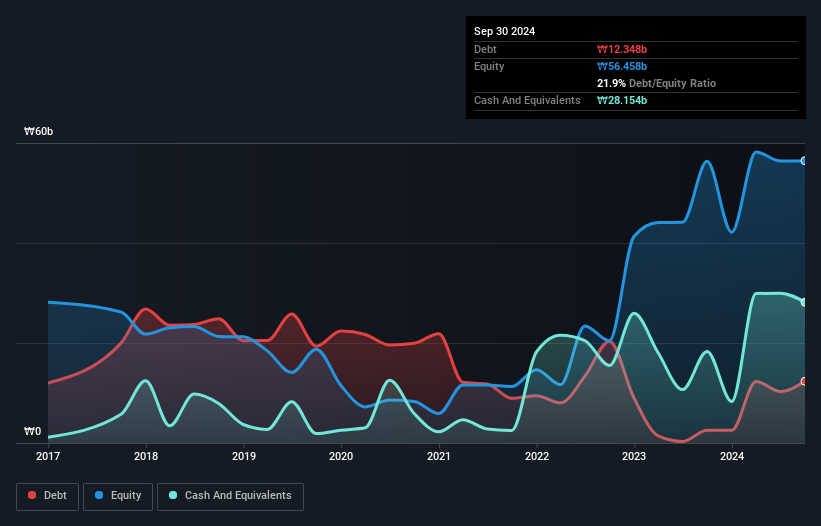The external fund manager backed by Berkshire Hathaway's Charlie Munger, Li Lu, makes no bones about it when he says 'The biggest investment risk is not the volatility of prices, but whether you will suffer a permanent loss of capital.' It's only natural to consider a company's balance sheet when you examine how risky it is, since debt is often involved when a business collapses. As with many other companies HUMAN TECHNOLOGY Co., Ltd (KOSDAQ:175140) makes use of debt. But should shareholders be worried about its use of debt?
What Risk Does Debt Bring?
Debt assists a business until the business has trouble paying it off, either with new capital or with free cash flow. In the worst case scenario, a company can go bankrupt if it cannot pay its creditors. However, a more common (but still painful) scenario is that it has to raise new equity capital at a low price, thus permanently diluting shareholders. Of course, plenty of companies use debt to fund growth, without any negative consequences. When we think about a company's use of debt, we first look at cash and debt together.
View our latest analysis for HUMAN TECHNOLOGY
What Is HUMAN TECHNOLOGY's Net Debt?
The image below, which you can click on for greater detail, shows that at September 2024 HUMAN TECHNOLOGY had debt of ₩12.3b, up from ₩2.55b in one year. However, its balance sheet shows it holds ₩28.2b in cash, so it actually has ₩15.8b net cash.

How Strong Is HUMAN TECHNOLOGY's Balance Sheet?
The latest balance sheet data shows that HUMAN TECHNOLOGY had liabilities of ₩18.6b due within a year, and liabilities of ₩656.6m falling due after that. On the other hand, it had cash of ₩28.2b and ₩7.16b worth of receivables due within a year. So it actually has ₩16.1b more liquid assets than total liabilities.
This surplus suggests that HUMAN TECHNOLOGY has a conservative balance sheet, and could probably eliminate its debt without much difficulty. Succinctly put, HUMAN TECHNOLOGY boasts net cash, so it's fair to say it does not have a heavy debt load! When analysing debt levels, the balance sheet is the obvious place to start. But you can't view debt in total isolation; since HUMAN TECHNOLOGY will need earnings to service that debt. So when considering debt, it's definitely worth looking at the earnings trend. Click here for an interactive snapshot.
Over 12 months, HUMAN TECHNOLOGY reported revenue of ₩48b, which is a gain of 65%, although it did not report any earnings before interest and tax. Shareholders probably have their fingers crossed that it can grow its way to profits.
So How Risky Is HUMAN TECHNOLOGY?
Statistically speaking companies that lose money are riskier than those that make money. And the fact is that over the last twelve months HUMAN TECHNOLOGY lost money at the earnings before interest and tax (EBIT) line. Indeed, in that time it burnt through ₩6.2b of cash and made a loss of ₩16b. While this does make the company a bit risky, it's important to remember it has net cash of ₩15.8b. That means it could keep spending at its current rate for more than two years. With very solid revenue growth in the last year, HUMAN TECHNOLOGY may be on a path to profitability. By investing before those profits, shareholders take on more risk in the hope of bigger rewards. The balance sheet is clearly the area to focus on when you are analysing debt. But ultimately, every company can contain risks that exist outside of the balance sheet. To that end, you should learn about the 4 warning signs we've spotted with HUMAN TECHNOLOGY (including 2 which make us uncomfortable) .
If you're interested in investing in businesses that can grow profits without the burden of debt, then check out this free list of growing businesses that have net cash on the balance sheet.
Valuation is complex, but we're here to simplify it.
Discover if HUMAN TECHNOLOGY might be undervalued or overvalued with our detailed analysis, featuring fair value estimates, potential risks, dividends, insider trades, and its financial condition.
Access Free AnalysisHave feedback on this article? Concerned about the content? Get in touch with us directly. Alternatively, email editorial-team (at) simplywallst.com.
This article by Simply Wall St is general in nature. We provide commentary based on historical data and analyst forecasts only using an unbiased methodology and our articles are not intended to be financial advice. It does not constitute a recommendation to buy or sell any stock, and does not take account of your objectives, or your financial situation. We aim to bring you long-term focused analysis driven by fundamental data. Note that our analysis may not factor in the latest price-sensitive company announcements or qualitative material. Simply Wall St has no position in any stocks mentioned.
About KOSDAQ:A175140
Adequate balance sheet with slight risk.
Market Insights
Weekly Picks


Crazy Undervalued 42 Baggers Silver Play (Active & Running Mine)


Fiducian: Compliance Clouds or Value Opportunity?

Willamette Valley Vineyards (WVVI): Not-So-Great Value
Recently Updated Narratives

Halyk Bank of Kazakhstan will see revenue grow 11% as their future PE reaches 3.2x soon

Silver's Breakout to over $50US will make Magma’s future shine with drill sampling returning 115g/t Silver and 2.3 g/t Gold at its Peru Mine

SEGRO's Revenue to Rise 14.7% Amidst Optimistic Growth Plans
Popular Narratives


MicroVision will explode future revenue by 380.37% with a vision towards success


NVDA: Expanding AI Demand Will Drive Major Data Center Investments Through 2026




